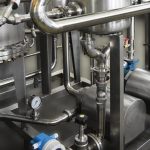Separation processes such as ultrafiltration (UF), reverse osmosis (RO) are being used more and more in the dairy industry.
They compete with conventional processes such as evaporation, distillation and absorption. The advantages of the membrane techniques are mainly that the concentration takes place at low temperatures and without changing the state of aggregation.
In the membrane processes the solution with the material to be separated diffuses or flows through different types of membranes. In the processes the solution is forced through the membrane under pressure and particles with a sufficiently high molecular weight are separated. Ultrafiltration, or UF, can be used for dividing whey into one protein-rich fraction and one fraction poor in protein, known as concentrate and ultrafiltrate respectively.
As it was mentioned, separation takes place under pressure through a thin membrane which allows the smaller constituents of the whey (minerals) to pass while the large molecules (proteins) are retained. The liquid that, after UF, contains the separated, high-molecular material is called concentrate, or retentate, and the clarified liquid that passes the membrane is called ultrafiltrate or permeate.
The membrane is made of a synthetic, polymeric material and the filtering properties vary with material composition and porosity. The product pressure required is determined by the membrane and is max. 10 bar for normal modules.




